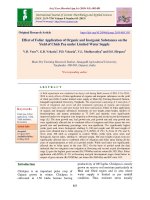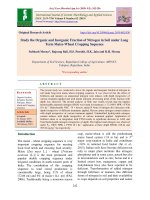Sustenance of soil fertility under organic and inorganic mulching in acid lime (Citrus aurantifolia Swingle)
Bạn đang xem bản rút gọn của tài liệu. Xem và tải ngay bản đầy đủ của tài liệu tại đây (138.53 KB, 4 trang )
Int.J.Curr.Microbiol.App.Sci (2020) 9(7): 2320-2323
International Journal of Current Microbiology and Applied Sciences
ISSN: 2319-7706 Volume 9 Number 7 (2020)
Journal homepage:
Original Research Article
/>
Sustenance of Soil Fertility under Organic and Inorganic Mulching in Acid
Lime (Citrus aurantifolia Swingle)
Esther Lalruatsangi1*, A.S. Mailappa2 and B.N. Hazarika3
1
Department of Fruit Science, College of Horticulture, Central Agricultural University,
Thenzawl, Mizoram, India
2
Department of Natural Resource Management, College of Horticulture and Forestry,
Central Agricultural University, Pasighat, Arunachal Pradesh, India
3
Department of Fruit Science, College of Horticulture and Forestry, Central Agricultural
University, Pasighat, Arunachal Pradesh, India
*Corresponding author
ABSTRACT
Keywords
Acid lime, Organic
mulch, Inorganic
mulch, Soil
properties
Article Info
Accepted:
20 June 2020
Available Online:
10 July 2020
An investigation was carried out to study the effects of organic and
inorganic mulching on soil properties in acid lime at Fruit Research Farm,
College of Horticulture and Forestry, Central Agricultural University,
Pasighat, Arunachal Pradesh. The experiment was laid out in Randomized
Block Design with 9 treatments and 3 replications. The maximum moisture
content (36.06 %) was observed in polythene mulch with black side facing
upward (T8) while maximum organic carbon (3.11 %), available nitrogen
(428.47 kg/ha), phosphorus (45.17 kg/ha) and potassium (575.06 kg/ha)
content was recorded by saw dust mulch (T7). The treatment recorded
highest microbial population of bacteria (83.45 × 105) in paddy straw
mulch (T4) and fungi (119.34 × 105) in rice husk mulch (T5). The study
revealed that organic mulches have beneficial effect on soil properties as
compared to inorganic mulches. Among the treatments, saw dust and paddy
straw mullch proves to be the best ideal treatment for improving soil
properties in acid lime.
Introduction
Acid lime (Citrus aurantifolia Swingle) is the
third important citrus fruit crop in India next
to mandarin and sweet orange (Chadha,
2002). The fruit is valued not only for its
nutritional
qualities
but
also
for
pharmaceutical, nutraceutical, cosmeceutical,
2320
Int.J.Curr.Microbiol.App.Sci (2020) 9(7): 2320-2323
medicinal and health value. The quality
production of Citrus fruits is highly dependent
on the soil moisture availability. In North
Eastern Region, rainfall increase gradually
from the month of March which continues up
to last week of October wherein maximum
rainfall is observed during the month of June
to September from South-West monsoon.
However, the months of November to March
are deprived of rainfall thus producing a dry
period. Proper management of available
irrigation water and conservation of moisture
for longer duration in the root zone of the tree
canopy plays an important role in enhancing
the yield and quality of fruits in acid lime.
Mulching plays an important role in
conservation of soil moisture during dry
periods, as well as improves physical,
biological and chemical properties of soil. It
is a practice, which helps in proper growth
and development of the plants by modifying
soil temperature, providing better nutrient
availability and by better moisture
conservation (Kher et al., 2010). Organic
mulches and inorganic mulch are efficient in
reduction of nitrates leaching, improve soil
physical properties, prevent erosion, supply
organic matter, regulate temperature and
water retention, improve nitrogen balance,
take part in nutrient cycle as well as increase
the biological activity (Muhammad et al.,
2009; Sarolia and Bhardwaj, 2012). Organic
mulches are derived from plant and animal
while inorganic mulches such as plastic
mulch are permanent and do not decompose
over time. The effective use of polyethylene
and organic mulches was evaluated for
improving the growth, yield and quality of the
Coorg mandarin (Mustaffa, 1989), Assam
lemon (Nath and Sharma, 1993), Nagpur
mandarin (Shirgure et al., 2003) and acid lime
(Shirgure, 2012). The information on
mulching materials and its effect on soil
health in acid lime suitable for North Eastern
conditions was not known. Therefore, an
investigation was done to find out the effect
of organic and inorganic mulching materials
on soil properties in acid lime.
Materials and Methods
The experiment was carried out on 6 years old
of acid lime var. PKM 1 planted at spacing of
3m × 3m, these plants were treated with
different mulches at Fruit Research Farm,
College of Horticulture and Forestry, Central
Agricultural University, Pasighat, Arunachal
Pradesh. The experiment consisted of nine
treatments in a Randomized Block design
with three replications. The treatments were
T1 = No mulch (Control), T2 = Dry grasses, T3
= Banana leaves, T4 = Paddy straw, T5 = Rice
husk, T6 = Wood shavings, T7 = Saw dust, T8
= Polythene mulch with black side facing
upward and T9 = Polythene mulch with silver
side facing upward. The dry grasses mulch
and banana leaves mulch materials were
imposed on 3 kg/basin around the tree trunk,
while the remaining organic mulch materials
viz. paddy straw, rice husk, wood shavings
and saw dust was applied as 6 cm/ thickness
around the canopy during the study period.
The surface (0-15 cm) soil samples were used
for analyzing the soil properties. The soil
properties were determined using soil
analytical methods given by Jackson (1973).
Organic carbon content determined by wet
digestion method of Walkley and Black,
available nitrogen (N) by Kjeldahl’s method,
available phosphorous (P) by Bray and Kurtz
method and available potassium (K) by flame
photometric method. The data collected on
various parameters have been statistically
analysed as per the method of Panse and
Sukhatme (1978).
Results and Discussion
The effect of various mulching materials on
soil moisture content, organic carbon,
available nitrogen, phosphorus, potassium
content and microbial population has been
2321
Int.J.Curr.Microbiol.App.Sci (2020) 9(7): 2320-2323
observed showing a great significance
although there was no significant observation
regarding the soil pH. The maximum soil
moisture content (36.06 %) was observed in
polythene mulch with black side facing
upward (T8) while organic carbon (3.11 %),
available nitrogen (428.47 kg/ha), available
phosphorus (45.17 kg/ha) and potassium
(575.06 kg/ha) in saw dust mulch (T7) (Table
1). The different mulching materials had
shown variations in different soil properties.
The available nitrogen status in post harvest
soils increased successively with increasing
nitrogen levels which was due to integration
of organic and inorganic sources and also due
to increased microbial activity which could
have stimulated the nitrification process.
Among the organic mulches, saw dust mulch
(T7) proves to have a profound beneficial
effect on the soil properties although the other
treatments were in par with T7.
Table.1 Effect of organic and inorgnic mulching on soil parameters
Treatments
T1
T2
T3
T4
T5
T6
T7
T8
T9
S.Ed±
C.D
at 5%
Soil pH
5.45
5.37
5.41
5.53
5.32
5.97
5.90
5.33
5.32
N.S
Soil
moisture
content (%)
Organic
carbon
(%)
24.20
33.66
29.11
30.26
28.66
26.73
29.66
36.06
35.25
2.99
6.34
2.19
2.85
2.49
3.03
2.94
2.76
3.11
2.60
2.56
0.21
0.44
The experimental study concluded that both
organic and inorganic mulching materials had
significantly influenced moisture conservation
and nutrient content in acid lime as compared
to control (no mulch). The moisture
regulation is of utmost importance and needs
to be emphasized as a priority at critical
stages of growth. Moisture conservation was
found to be higher in inorganic mulch due to
use of synthetic plastic materials. Higher
nutrient inputs in the soil occurred under
organic mulch conditions. The organic
mulches such as paddy straw (T4), rice husk
(T5) and saw dust mulches (T7) reveals to give
the best results for improving soil properties
Available Available
nitrogen phosphorus
(kg/ha)
(kg/ha)
296.83
388.80
347.10
367.63
376.27
409.73
428.47
355.77
334.70
33.98
72.03
24.27
44.80
31.73
41.81
42.93
38.08
45.17
36.21
34.34
5.96
12.65
Available
potassium
(kg/ha)
440.83
511.46
482.16
556.92
559.35
527.86
575.06
520.43
514.13
32.17
68.21
of acid lime. The inorganic mulch gives good
result but organic mulches such as rice husk,
paddy straw and saw dust mulches are more
recommended as compared to the inorganic
mulch since they are readily available raw
material resulting higher cost benefit ratio.
References
Chadha, K.L. Limes and Lemons. In:
Handbook of Horticulture. Published by
Directorate
of
Information
and
Publication of Agriculture, ICAR,
Krishi Anusandhan Bhavan, Pusa, New
Delhi. 2002. pp. 209.
2322
Int.J.Curr.Microbiol.App.Sci (2020) 9(7): 2320-2323
Jackson, M.L. Soil chemical analysis.
Prentice Hall of India Private Limited,
New Delhi. 1973.
Kher, R., Baba, J.A., Bakshi, P. Influence of
planting time and mulching material on
growth and fruit yield of strawberry cv.
Chandler.
Indian
Journal
of
Horticulture. 67th ed. Vol. 4. 2010. pp
441-444.
Muhammad, A.P., Muhammad, I., Khuram,
S., Anwar-UL-Hassan. 2009. Effect of
mulch on soil physical properties and
NPK concentration in maize (Zea mays)
shoots under two tillage system.
International Journal of Agriculture
and Biology. 11th ed. 2009. pp 120-124.
Mustaffa M M. 1989. Effect of mulching and
shade on yield, quality and leaf nutrient
composition of Coorg mandarin. Indian
Journal of Horticulture, 46th ed. Vol. 3.
1989. pp. 344-347.
Nath J C., Sharma R. 1993. Leaf chlorophyll
and leaf relative water of Assam lemon
(Citrus limon B.) as affected by organic
mulches. South Indian Horticulture,
41th ed. Vol. 4. 1993. pp. 225-226.
Panse, V.G., Sukhatme, D.K. Statistical
Methods for Agricultural Workers (3rd
ed.), ICAR, New Delhi. 1974
Sarolia, D.K., Bhardwaj, R.L. Effect of
mulching on crop production under
rainfed
conditionA
Review.
International Journal of Research in
Chemistry and Environment. 2nd ed.
2012. pp. 8-20.
Shirgure, P.S. 2012. Sustainable acid lime
fruit production and soil moisture
conservation with different mulches.
Agricultural Engineering Today. 36th
ed. Vol. 3. 2012. pp. 21-26
Shirgure, P.S., Sonkar, R.K., Singh, S.,
Panigrah, P. 2003. Effect of different
mulches on soil moisture conservation,
weed reduction, growth and yield of
drip irrigated Nagpur mandarin (Citrus
reticulata).
Indian
Journal
of
Agricultural Sciences. 73rd ed. Vol. 3.
2003. pp. 148-152.
How to cite this article:
Esther Lalruatsangi, A.S. Mailappa and Hazarika, B.N. 2020. Sustenance of Soil Fertility under
Organic and Inorganic Mulching in Acid Lime (Citrus aurantifolia Swingle).
Int.J.Curr.Microbiol.App.Sci. 9(07): 2320-2323. doi: />
2323









